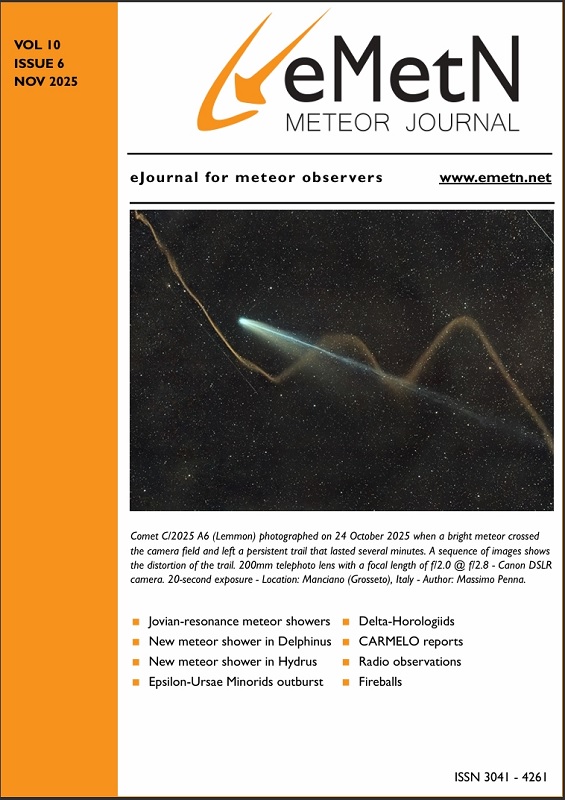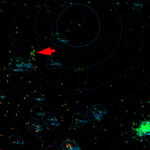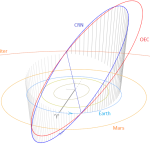Mariasole Maglione (Gruppo Astrofili Vicentini)
Lorenzo Barbieri (CARMELO network and AAB: Associazione Astrofili Bolognesi)
Introduction
January opened with the peak of the Quadrantids, which is the main and dominant shower for the entire month, otherwise affected only by the passage of minor showers. The peak of the Quadrantids occurred on January 3.
Methods
The CARMELO network consists of SDR radio receivers. In them, a microprocessor (Raspberry) performs three functions simultaneously:
- By driving a dongle, it tunes the frequency on which the transmitter transmits and tunes like a radio, samples the radio signal and through the FFT (Fast Fourier Transform) measures frequency and received power.
- By analyzing the received data for each packet, it detects meteoric echoes and discards false positives and interference.
- It compiles a file containing the event log and sends it to a server.
The data are all generated by the same standard, and are therefore homogeneous and comparable. A single receiver can be assembled with a few devices whose total current cost is about 210 euros.
To participate in the network read the instructions on this page.
January data
In the plots that follow, all available at this page, the abscissae represent time, which is expressed in UT (Universal Time) or in solar longitude (Solar Long), and the ordinates represent the hourly rate, calculated as the total number of events recorded by the network in an hour divided by the number of operating receivers.
In fig.1, the trend of signals detected by the receivers for the month of January.
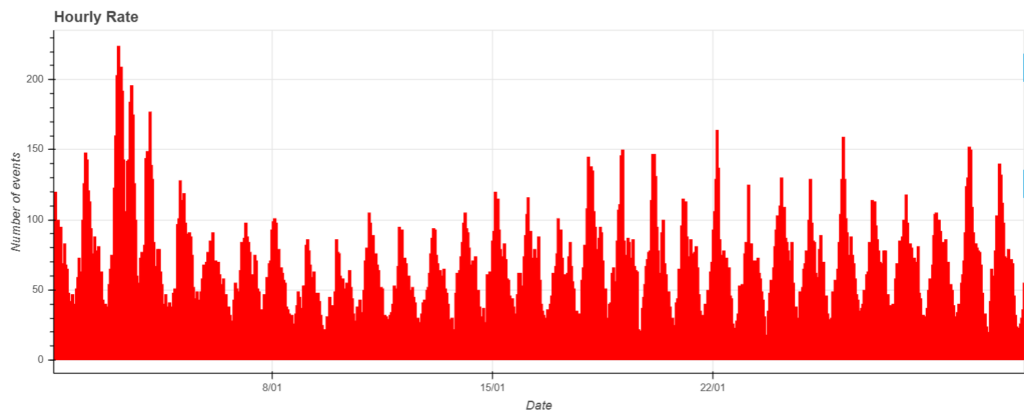
Fig. 1: January 2025 data trend.
Quadrantids
Among the annual meteor showers, the January Quadrantids usually stand out for their intensity, reaching peaks of activity between 60 and 200 meteors per hour. Despite this, they remain less well known than other more famous showers, such as the Perseids or Geminids. Their less notoriety is also due to the very short peak of activity, which lasts about 24 hours.
The radiant of the Quadrantids is located in the Boote constellation, in a rather low position in the northern sky, between the head of the Dragon and the helm of the Big Dipper. The name is derived from Quadrans Muralis, an ancient constellation created in 1795 by the French astronomer Jérôme Lalande that included parts of Boote and the Dragon, and which is not on the list of 88 constellations drawn up by the International Astronomical Union (IAU) in 1922 and published in 1930 (1).
The origin of this swarm remains a debated topic. In 2003, following an observational campaign on minor bodies in the Solar System, astronomer Peter Jenniskens found a possible progenitor body of the Quadrantids in the Near Earth (196256) asteroid 2003 EH1, a hypothesis that would make them one of the few meteor showers arising from an asteroid and not a comet, similar to the Geminids in December (2). Since then, 2003 E1 has been considered the most likely progenitor body of the Quadrantids. It may itself be a fragment of comet C/1490 Y1 , which was observed by Chinese, Japanese and Korean astronomers just over 500 years ago in 1490 (3).
This year, the maximum peak of the Quadrantids was expected on Jan. 3 at solar longitude 283.2°, corresponding to 17 UT. At that time, however, the radiant of the swarm was too low on the horizon for proper detection. The CARMELO network detected the maximum activity at 3 UT on Jan. 3 at solar longitude 286.6°, when the hourly rate was 224, and the Quadrantids’ radiant was high in the sky to the northeast (fig.2, with black strokes below highlighting the times of day when the radiant was high enough above the horizon for observation).

Fig.2: Peak of maximum activity of the Quadrantids on Jan. 3 detected at solar longitude 282.6°, and peak expected at 283.2° when the radiant was too low on the horizon.
Quadrantids’ composition
Fig. 3 shows a comparison of the hourly rate and average duration of meteoric echoes on the days around the peak of Quadrantid activity.
Note how the three peaks on Jan. 3 and 4 in the two graphs are very different: the central peak, around solar longitude 283° corresponding to 13 UT on Jan. 3, has much longer echoes; the average duration also reaches half a second.
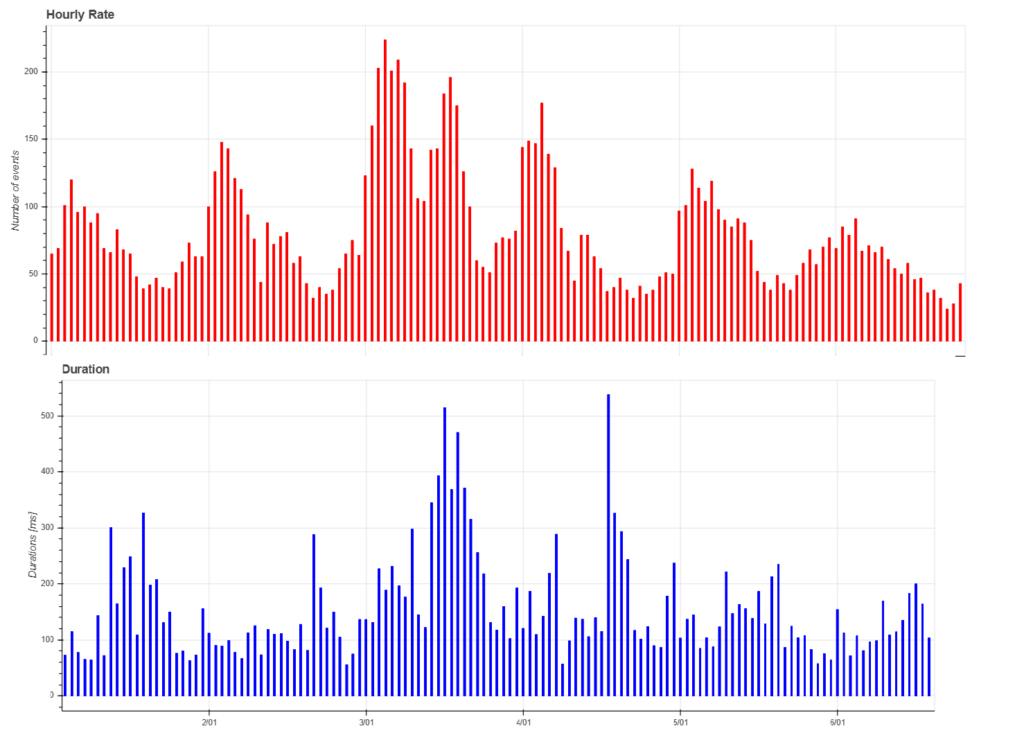
Fig. 3: Comparison of hourly rate and average duration of meteoric echoes between Jan. 1 and Jan. 6.
This observation tells us a lot about the composition of this shower. In fact, the duration of a radio echo depends on the time it takes for the meteor to dissolve: the greater the number of ionized atoms (ions and free electrons), the longer the deionization process takes. The number of ionized atoms, or the density of the plasma, is proportional to the kinetic energy of the impacting bodies against the first molecules in the ionosphere: the more energetic the collision, the more atoms disintegrate, and thus the denser the meteor.
We know that kinetic energy is given by:
Ec = ½ mv2
and we know that all meteors belonging to the same shower all travel at the same velocity v. It can therefore be deduced that the only parameter that varies is m, i.e., mass.
The graph thus shows that the Quadrantid shower can be described as a cylinder having a “shell” of smaller meteors on the outside, and a filament of larger meteors on the inside. This characteristic is typical of relatively young showers (in astronomical times, of course). With the passage of time, in fact, this composition tends to change, either due to the effect of gravitational interactions with the major planets in the Solar System, or due to the pressure of solar radiation, which tends to move the more massive particles outward from the shower, thus generating a conformation that is no longer symmetrical.
Note how in the bottom graph in fig. 3, the spike in density increase toward solar longitude 284° (between Jan. 4 and 5) is not a false positive, or a system error. It was also present at the passage of the Quadrantids in January 2023 and detected by CARMELO (4).
The CARMELO network
The network currently consists of 14 receivers, 13 of which are operational, located in Italy, the UK, Croatia and the USA. The European receivers are tuned to the Graves radar station frequency in France, which is 143.050 MHz. Participating in the network are:
- Lorenzo Barbieri, Budrio (BO) ITA
- Associazione Astrofili Bolognesi, Bologna ITA
- Associazione Astrofili Bolognesi, Medelana (BO) ITA
- Paolo Fontana, Castenaso (BO) ITA
- Paolo Fontana, Belluno (BL) ITA
- Associazione Astrofili Pisani, Orciatico (PI) ITA
- Gruppo Astrofili Persicetani, San Giovanni in Persiceto (BO) ITA
- Roberto Nesci, Foligno (PG) ITA
- MarSEC, Marana di Crespadoro (VI) ITA
- Gruppo Astrofili Vicentini, Arcugnano (VI) ITA
- Associazione Ravennate Astrofili Theyta, Ravenna (RA) ITA
- Akademsko Astronomsko Društvo, Rijeka CRO
- Mike German a Hayfield, Derbyshire UK
- Mike Otte, Pearl City, Illinois USA
The authors’ hope is that the network can expand both quantitatively and geographically, thus allowing the production of better quality data.
References
(1) Eugène Delporte (1930), IAU: “Délimitation Scientifique des Constellations”. At the University Press
(2) Peter Jenniskens (2004): “2003 EH_1 and the Quadrantid shower”. WGN, Journal of the International Meteor Organization, vol. 32, no.1, p.7-10
(3) Ki-Won Lee et al. (2009): “Orbital Elements of Comet C/1490 Y1 and the Quadrantid shower”. Monthly Notices of the Royal Astronomical Society, vol. 400
(4) Lorenzo Barbieri (2023): “The 2023 Quadrantidis”. eMeteorNews

